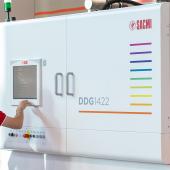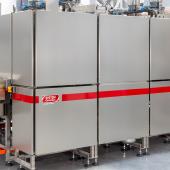New Machinery Regulation: regulatory and safety obligations
Stefano Lugli*, ACIMAC (Modena, Italy) [email protected]
The new Regulation (EU) 2023/1230 published in the Official Journal of the European Union on 29 June will entirely replace the existing Directive 2006/42/EC (“Machinery Directive”) as of 20 January 2027. This means that technology manufacturers have three years to adapt to the new requirements outlined below.
The new Machinery Regulation was approved following a lengthy and contentious legislative process. While all Member States have acknowledged the need to take account of emerging technologies and the need for greater simplification and clarity in specific provisions, the results are not entirely satisfactory.
Although the Regulation addresses key issues such as digital technologies, artificial intelligence, digitalisation and the application of cybersecurity to machinery, it has missed a significant opportunity to clarify longstanding sensitive and controversial aspects, including the definition of machinery and partly completed machinery.
During the approval process, differences of opinion also emerged between individual countries, with some – most notably France – advocating for an expanded list of hazardous machinery requiring prior certification by a notified body, while other countries such as Italy and Germany opposed this proposal. This debate has had direct consequences for the ceramic and heavy clay machinery industry as it included a proposal to place palletizers, depalletizers and end-of-line solutions in general on the list of hazardous machinery.
In response, ACIMAC (Italian Ceramic Machinery and Equipment Manufacturers’ Association), in collaboration with Confindustria Rome and Confindustria’s Delegation to the EU in Brussels, took action to make European authorities and MEPs aware of the impracticality of such a measure and successfully worked to have it overturned.
In addition, the Association’s efforts contributed to the publication of an improved text compared to the initial proposal published by the EU Commission on 21 April 2021.
Changes compared to the past
As mentioned, the Regulation incorporates numerous new elements but also displays a number of critical aspects, which will hopefully be clarified in a future EU Guide to Application.
One particularly important new aspect is the fact that the legislation is drafted through the legal instrument of an EU Regulation. In other words, a Directive (EU legislation that needs to be enacted by individual Member States) has been transformed into a Regulation (EU legislation that is directly applicable in all Member States).
Transforming the Directive into a Regulation ensures more uniform implementation across the EU, avoids delays resulting from the slow pace of enactment by individual Member States (including Italy, unfortunately), and consequently provides greater legal certainty.
It is important to note that the European Commission has stated on multiple occasions that voluntary adoption of the Regulation is not permitted before the date of application. This means, for example, that prior to 20 January 2027, manufacturers will be unable to issue EC Declarations of Conformity under Regulation 2023/1230 even if they have already essentially complied with the new technical requirements.
Nonetheless, there is nothing to prevent manufacturers from voluntarily adhering to the new technical requirements in advance based on contractual agreements.
At the same time, manufacturers will need to carefully manage issues relating to product deliveries made in late 2026 and early 2027, including contractual aspects, given that from 20 January 2027 the new Regulation 2023/1230 will apply to all machines placed on the market or put into service from that date onwards.
One essential aspect of relevance to the ceramic industry is that machine installation is almost always performed by the manufacturer himself and can essentially be considered an integral part of the on-site manufacturing process.
The most significant new aspects of the Regulation are outlined below, distinguishing between “Legislative Articles” (Articles 1 to 54) and “Essential Safety Requirements” (new Annex III).
Definition of partly completed machinery
Unfortunately, the main definitions of machinery and partly completed machinery have remained largely unchanged, leaving both definitions fairly vague.
The only clarification in the definition of machinery is that it is “missing only the upload of software intended for the specific application foreseen by the manufacturer”, a stipulation made in response to the growing use of software as a safety component of machinery.
While the new definition of partly completed machinery addresses some of the critical aspects of the Directive (such as removing the word “almost” in the phrase “an assembly which is almost machinery”, which created uncertainty), it does not resolve the problem of clearly differentiating between machinery, partly completed machinery and components.
Introduction of the concept of “substantial modifications” to machinery
The issue of machinery modifications and the possible occurrence of a CE (re)marking obligation has always been a subject of much discussion and was initially addressed through legislation adopted by individual Member States. Only the various editions of Guides to application of the Machinery Directive have attempted to clarify the various aspects, while the Directive 2006/42/EC does not itself address this issue.
The new Regulation at last attempts to provide clarity, as it also applies to products that have undergone a “substantial modification”, in other words a modification:
- carried out by physical or digital means after that machinery or related product has been placed on the market or put into service
- which is not foreseen or planned by the manufacturer
- and which affects the safety of that machinery or related product by creating a new hazard or by increasing an existing risk, which requires the addition of guards or protective devices to that machinery or related product, the processing of which necessitates modification of the existing safety control system; or the adoption of additional protective measures to ensure the stability or mechanical strength of that machinery or related product.
This aspect is of the utmost importance in the ceramic industry. Manufacturers receive numerous commercial requests, even years after initial installation, to improve the performance of machinery, expand functions or to make other kinds of modifications. Some companies have even made upgrading their own or other manufacturers’ machinery an important area of their business. However, under the new Regulation manufacturers will be obliged to treat upgraded machinery in the same way as a new placement on the market, resulting in the need to comply with the technical standards in force at the time of the new CE marking.
The figures of importer and distributor
In accordance with the new legislative framework, the new Machinery Regulation introduces the figures of the importer and distributor (Article 3) and sets out their obligations.
The importer, i.e. the person who places a product within the scope of the Regulation from a third country on the EU market, merits special attention.
The importer has numerous obligations (Articles 13 and 14), including for example ensuring that only compliant machinery or related products are placed on the market, that the manufacturer has carried out the appropriate conformity assessment procedures (Article 25) and drawn up the technical documentation (Annex IV, Part A), and that the machinery or related product bears the CE marking, etc.
One observation: Regulation (EU) 2019/1020 on market surveillance and compliance of products, which came into effect in July 2021, applies to a wide range of regulations including the Machinery Directive, and already establishes these figures and their obligations. In other words, Regulation 2023/1230 merely reiterates rules that were already in force and which European manufacturers/distributors will have to be prepared for when importing products from outside the EU (Far East, Taiwan, etc.).
Security components: software
In the new Machinery Regulation, the definition of “safety component” covers not only physical devices but also digital devices, including software, making this the first regulation of its kind applicable to an intangible product.
Software that performs safety functions and is placed on the market separately must therefore bear the CE marking and be accompanied by an EU declaration of conformity and, where necessary, instructions for use.
Technical documentation
Finally, the Regulation introduces the possibility of providing the instructions for use in a digital format (Article 10), in which case the manufacturer must:
- mark on the machinery, on its packaging or in an accompanying document how to access the digital instructions;
- present the instructions in a format that makes it possible for the user to print and download them and save them on an electronic device (this requirement also applies where the instructions for use are embedded in the software of the machinery or related product);
- make them accessible online during the expected lifetime of the machinery and for at least 10 years after the placing on the market of the machinery;
- provide the instructions for use in paper format free of charge within one month, at the request of the user at the time of the purchase.
Essential Health and Safety Requirements (EHSRs)
A number of essential health and safety requirements (EHSRs) have been amended or added (Annex III), in particular to address machinery-specific risks associated with new digital technologies.
Specifically, the following EHSRs have been amended:
- 1.1.2 The principles of safety integration have been modified to allow users to verify the safety functions of the machines
- 1.1.6 on ergonomics
- 1.2.1 on control systems
- 1.3.7 on risks related to moving parts
- 1.6.2 on access to operating positions and servicing points
- 2.2.1.1 on instructions for use relating to vibrations
- 3.2.2 on seating
- 3.5.1 on batteries (a new requirement for batteries with automatic charging for mobile machinery)
- 3.6.3.3 on autonomous mobile machinery or related products
And the following requirements have been introduced:
- 1.1.9 on protection against corruption
- 3.2.4 on the supervisory function
- 3.5.4 on the risk of contact with live overhead power lines.
Artificial intelligence and cybersecurity
The new Machinery Regulation applies to systems that use artificial intelligence technologies for aspects that potentially concern the safety of machinery. In particular, risk assessment must take account of the evolution of the behaviour of machinery designed to operate with varying levels of autonomy.
With regard to the new essential health and safety requirement explicitly concerning the protection of IT systems against corruption, it is clear that IT security is an aspect that can no longer be neglected. Today, almost all machines are connected to data networks that may be the target of attacks. Such occurrences have already taken place and are bound to become more frequent in the future. For this reason, the new Regulation requires the safety-related control circuits to be designed in such a way as to prevent malicious attacks while maintaining correct machine behaviour. The machinery must also collect evidence of a legitimate or illegitimate intervention in that hardware component, when relevant for connection or access to software that is critical for the compliance of the machinery or related product. Similar requirements have been introduced for software.
The requirement relating to the safety and reliability of control systems (EHSR 1.2.1.) has been modified to require, amongst other things, that they are designed and constructed in such a way that “they can withstand, where appropriate to the circumstances and the risks, the intended operating stresses and intended and unintended external influences, including reasonably foreseeable malicious attempts from third parties leading to a hazardous situation”.
Human-machine interaction
Control systems of machinery with fully or partially self-evolving behaviour or logic that are designed to operate with varying levels of autonomy must meet specific design and construction requirements. In this connection, the EHSRs relating to ergonomics (1.1.6.) have also been modified.
Some requirements have been modified to take account of human-machine interactions, such as the one concerning risks related to moving parts (EHSR 1.3.7.). This requirement now specifies that “the prevention of risks of contact leading to hazardous situations and the psychological stress that may be caused by the interaction with the machinery shall be adapted to human-machine coexistence in a shared space without direct collaboration and human-machine interaction”.
In practice, the traditional methods of protecting human operators by segregating danger zones are no longer applicable when humans and machines have to operate in a shared workspace, as is the case in applications with collaborative robots (or cobots). The psychological stress caused by these work situations must also be taken into account.
The Regulation has amended the requirement concerning access to operating positions and servicing points (EHSR 1.6.2.), specifying that “in the case of machinery into which persons shall enter for operation, adjustment, maintenance or cleaning, the machinery accesses shall be dimensioned and adapted for the use of rescue equipment”.
Conclusions
The new Regulation has achieved many of the objectives the Commission had set itself. These include addressing innovative digital technologies, mitigating emerging risks and cybersecurity concerns, promoting innovation and digitalisation, and introducing substantial changes to address issues that had remained unresolved for years.
The Regulation will have a significant impact on companies in the ceramic technology sector. The fact that machinery and production lines are constantly interconnected for the purposes of managing production data means that they are all subject to rules designed to prevent the occurrence of safety-related risks arising from cybersecurity breaches.
Addressing this issue will be particularly challenging for SMEs, as they may need to adopt relatively unfamiliar technological solutions. They are also exposed to the risk of improvised consultants or experts recommending overly expensive solutions that still fail to ensure regulatory compliance.
To support the industry during this process, ACIMAC plans to draw up sector-wide application guidelines and continue offering technical and regulatory training courses on the new Machinery Regulation in collaboration with SBS.
* Stefano Lugli is Head of the ACIMAC Technical Department,
a member of CEN TC 146 on Safety of Packaging Machinery
and a member of the ISO 313 Safety of Packaging Machinery working group
Did you find this article useful?
Join the CWW community to receive the most important news from the global ceramic industry every two weeks





















